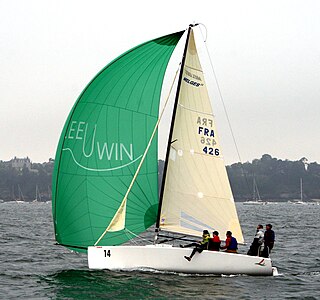
The Melges 24 is an American trailerable sailboat that was designed by Reichel/Pugh as a one-design racer and first built in 1993.
The Flying Tiger 10 M is a Chinese trailerable sailboat that was designed by American Robert Perry as a one design racer and first built in 2005.
The Santana 22 is an American trailerable sailboat, that was designed by Gary Mull and first built in 1966.

The Farr 30, originally called the Mumm 30, is a sailboat that was designed by Bruce Farr as a one design racer and first built in 1995.

The Swan 48 Frers, also called the Swan 48-2 and the Swan 48-2 Frers, is a Finnish sailboat that was designed by Germán Frers as a blue water cruiser-racer and first built in 1995.
The Swan 53, sometimes called the Swan 53 Mk I, is a Finnish sailboat that was designed by Germán Frers as a cruiser-racer and first built in 1987.
The Rocket 22 is a Canadian trailerable sailboat, that was designed by American Gary Mull and Canadian Don Martin as a racer and first built in 2002.
The Santana 27 is an American sailboat, that was designed by Gary Mull and first built in 1967. The design is out of production.

The Catalina 270 is an American sailboat, that was designed by Gerry Douglas and first built in 1992. The design is out of production.

The Fantasia 27 is a French sailboat, that was designed by Philippe H. Harlé and first built in 1981.

The Beneteau Figaro 2 or Beneteau Figaro II, officially designated as the Figaro Beneteau II, is a French sailboat that was designed by Marc Lombard as a one design, single-handed, off-shore racer for the Solitaire du Figaro race and first built in 2003. The boat and the race are named for the race's sponsor, the French newspaper Le Figaro.
The Capri 14 is an American trailerable sailboat that was designed by Barney Lehman and W. D. Schock as a day sailer and first built in 1960.
The Harbor 14 is an American trailerable sailboat that was designed by Barney Lehman and William D. Schock as a day sailer and first built in 2004.

The Harbor 20 is an American trailerable sailboat that was designed by W. D. Schock Corp's Steve Schock as a day sailer and one design club racer. It was first built in 1997.
The Santana 26 is an American trailerable sailboat that was designed by W. D. Schock Corp's in-house designer, Seymour Paul, as a cruiser and first built in 1971.
The Schock 25 is an American trailerable sailboat that was designed by W. D. Schock Corp's in-house designer, Seymour Paul as a day sailer and first built in 1961.
The Schock 40 is an American sailboat that was designed by DynaYacht as a racer and first built in 2000.
The Flying Tiger 7.5 is a Chinese trailerable sailboat that was designed by American naval architect Robert Perry as a one design racer. It was first built in 2009.
The Mini JOD is a French trailerable sailboat that was designed by Daniel Andrieu as a one design racer and first built in 1994.
The Sun Fast 36 is a French sailboat that was designed by Philippe Briand as a cruiser-racer and first built in 1994.








